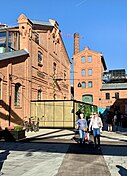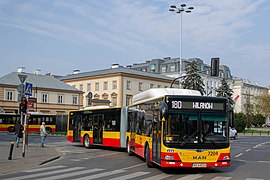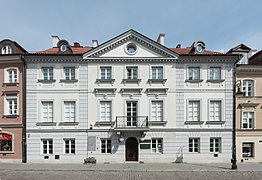Warsaw
Warsaw
Warszawa ( Warsaw Old Town | |
|---|---|
|
WMI) (not in Warsaw) | |
| Rapid transit system | Metro |
| Website | warszawa.pl |
Europe | |
Warsaw,[a] officially the Capital City of Warsaw,[7][b] is the capital and largest city of Poland. The metropolis stands on the River Vistula in east-central Poland. Its population is officially estimated at 1.86 million residents within a greater metropolitan area of 3.27 million residents, which makes Warsaw the 7th most-populous city in the European Union.[2] The city area measures 517 km2 (200 sq mi) and comprises 18 districts, while the metropolitan area covers 6,100 km2 (2,355 sq mi).[8] Warsaw is an alpha global city,[9] a major cultural, political and economic hub, and the country's seat of government. It is also capital of the Masovian Voivodeship.
Warsaw traces its origins to a small fishing town in
Warsaw is served by two international airports, the busiest being
The city is home to renowned universities such as the
Toponymy and names
Warsaw's name in the Polish language is Warszawa. Other previous spellings of the name may have included: Warszewa, Warszowa, Worszewa or Werszewa.[19][20] The exact origin and meaning of the name is uncertain and has not been fully determined.[21][22] Originally, Warszawa was the name of a small fishing settlement on the banks of the Vistula river. One theory states that Warszawa means "belonging to Warsz", Warsz being a shortened form of the masculine Old Polish name Warcisław, which etymologically is linked with Wrocław.[23] However the ending -awa is unusual for a large city; the names of Polish cities derived from personal names usually end in -ów/owo/ew/ewo (e.g. Piotrków, Adamów).
Folk etymology attributes the city name to Wars and Sawa. There are several versions of the legend with their appearance. According to one version, Sawa was a mermaid living in the Vistula with whom fisherman Wars fell in love.[24][25] The official city name in full is miasto stołeczne Warszawa ("The Capital City of Warsaw").[26]
A native or resident of Warsaw is known as a Varsovian – in Polish warszawiak, warszawianin (male), warszawianka (female), warszawiacy, and warszawianie (plural).
History
1300–1800
The first fortified settlements on the site of today's Warsaw were located in Bródno (9th/10th century) and Jazdów (12th/13th century).[27] After Jazdów was raided by nearby clans and dukes, a new fortified settlement was established on the site of a small fishing village called "Warszowa". The Prince of Płock, Bolesław II of Masovia, established the modern-day city in about 1300 and the first historical document attesting to the existence of a castellany dates to 1313.[28] With the completion of St John's Cathedral in 1390, Warsaw became one of the seats of the Dukes of Masovia and was officially made capital of the Masovian Duchy in 1413.[27] The economy then predominantly rested on craftsmanship or trade, and the town housed approximately 4,500 people at the time.
During the 15th century, the population migrated and spread beyond the northern city wall into a newly formed self-governing precinct called
In 1529, Warsaw for the first time became the seat of a
The reign of
Warsaw remained the capital of the
1800–1939

Warsaw was made the capital of a newly created
With the violation of the Polish constitution, the 1830 November Uprising broke out against foreign influence. The Polish-Russian war of 1831 ended in the uprising's defeat and in the curtailment of Congress Poland's autonomy.[27] On 27 February 1861, a Warsaw crowd protesting against Russian control over Congress Poland was fired upon by Russian troops.[41][42] Five people were killed. The Underground Polish National Government resided in Warsaw during the January Uprising in 1863–64.[42]
Warsaw flourished throughout the 19th century under Mayor Sokrates Starynkiewicz (1875–92), who was appointed by Alexander III. Under Starynkiewicz Warsaw saw its first water and sewer systems designed and built by the English engineer William Lindley and his son, William Heerlein Lindley, as well as the expansion and modernisation of trams, street lighting, and gas infrastructure.[27] Between 1850 and 1882, the population grew by 134% to 383,000 as a result of rapid urbanisation and industrialisation. Many migrated from surrounding rural Masovian towns and villages to the city for employment opportunities. The western borough of Wola was transformed from an agricultural periphery occupied mostly by small farms and windmills (mills being the namesake of Wola's central neighbourhood Młynów) to an industrial and manufacturing centre.[43] Metallurgical, textile and glassware factories were commonplace, with chimneys dominating the westernmost skyline.[44]
Like
During
The interwar period (1918–1939) was a time of major development in the city's infrastructure. New
Second World War

After the German
By July 1944, the
Hitler, ignoring the agreed terms of the capitulation, ordered the entire city to be razed to the ground and the library and museum collections taken to Germany or burned.[57] Monuments and government buildings were blown up by special German troops known as Verbrennungs- und Vernichtungskommando ("Burning and Destruction Detachments").[57] About 85% of the city was destroyed, including the historic Old Town and the Royal Castle.[59]
On 17 January 1945 – after the beginning of the
1945–1989
In 1945, after the bombings, revolts, fighting, and demolition had ended, most of Warsaw lay in ruins. The area of the former ghetto was razed to the ground, with only a sea of rubble remaining. The immense destruction prompted a temporary transfer of the new government and its officials to Łódź, which became the transitional seat of power. Nevertheless, Warsaw officially resumed its role as the capital of Poland and the country's centre of political and economic life.
After World War II, the "Bricks for Warsaw" campaign was initiated and large prefabricated housing projects were erected in Warsaw to address the major housing shortage.
Much of the central district was also designated for future skyscrapers. The 237-metre

John Paul II's visits to his native country in 1979 and 1983 brought support to the budding "Solidarity" movement and encouraged the growing anti-communist fervor there.[66] In 1979, less than a year after becoming pope, John Paul celebrated Mass in Victory Square in Warsaw and ended his sermon with a call to "renew the face" of Poland.[66] These words were meaningful for Varsovians and Poles who understood them as the incentive for liberal-democratic reforms.[66]
1989–present
In 1995, the Warsaw Metro opened with a single line.[67] A second line was opened in March 2015.[68] On 28 September 2022, three new Warsaw metro stations were opened, increasing the number of Warsaw Metro stations to 36 and its length to 38.3 kilometers.[69] In February 2023, Warsaw's mayor, Rafał Trzaskowski, announced plans to more than double the size of the city's metro system by 2050.[70]
With the entry of Poland into the
Geography
Location and topography

Warsaw lies in east-central Poland about 300 km (190 mi) from the
Warsaw is located on two main geomorphologic formations: the plain moraine plateau and the Vistula Valley with its asymmetrical pattern of different terraces. The Vistula River is the specific axis of Warsaw, which divides the city into two parts, left and right. The left one is situated both on the moraine plateau (10 to 25 m (33 to 82 ft) above Vistula level) and on the Vistula terraces (max. 6.5 m (21 ft) above Vistula level). The significant element of the relief, in this part of Warsaw, is the edge of moraine plateau called Warsaw Escarpment. It is 20 to 25 m (66 to 82 ft) high in the Old Town and Central district and about 10 m (33 ft) in the north and south of Warsaw. It goes through the city and plays an important role as a landmark.
The plain moraine plateau has only a few natural and artificial ponds and also groups of clay pits. The pattern of the Vistula terraces is asymmetrical. The left side consists mainly of two levels: the highest one contains former flooded terraces and the lowest one is the floodplain terrace. The contemporary flooded terrace still has visible valleys and ground depressions with water systems coming from the old Vistula – riverbed. They consist of still quite natural streams and lakes as well as the pattern of drainage ditches. The right side of Warsaw has a different pattern of geomorphological forms. There are several levels of the Vistula plain terraces (flooded as well as formerly flooded), and only a small part is a not-so-visible moraine escarpment. Aeolian sand with a number of dunes parted by peat swamps or small ponds cover the highest terrace. These are mainly forested areas (pine forest).
Climate

Warsaw experiences an oceanic (Köppen: Cfb) or humid continental (Köppen: Dfb) climate, depending on the isotherm used;[78][79] although the city used to be humid continental regardless of isotherm prior to the recent effect of climate change and the city's urban heat island.[80][81][82][83] Meanwhile, by the genetic climate classification of Wincenty Okołowicz, it has a temperate "fusion" climate, with both oceanic and continental features.[84]
The city has cold, sometimes snowy, cloudy winters, and warm, relatively sunny but frequently stormy summers. Spring and autumn can be unpredictable, highly prone to sudden weather changes; however, temperatures are usually mild, especially around May and September.[80] The daily average temperature ranges between −1.5 °C (29 °F) in January and 19.7 °C (67.5 °F) in July and the mean year temperature is 9.0 °C (48.2 °F). Temperatures may reach 30 °C (86 °F) in the summer, although the effects of hot weather are usually offset by relatively low dew points and large diurnal temperature differences. Warsaw is Europe's sixth driest major city (driest in Central Europe), with yearly rainfall averaging 482 mm (19.0 in), the wettest month being July.[85]
| Climate data for Warsaw (WAW), 1991–2020 normals, extremes 1951–present | |||||||||||||
|---|---|---|---|---|---|---|---|---|---|---|---|---|---|
| Month | Jan | Feb | Mar | Apr | May | Jun | Jul | Aug | Sep | Oct | Nov | Dec | Year |
| Record high °C (°F) | 18.9 (66.0) |
18.3 (64.9) |
22.9 (73.2) |
30.4 (86.7) |
32.8 (91.0) |
35.3 (95.5) |
35.9 (96.6) |
37.0 (98.6) |
34.5 (94.1) |
25.9 (78.6) |
19.2 (66.6) |
15.4 (59.7) |
37.0 (98.6) |
| Mean maximum °C (°F) | 8.6 (47.5) |
10.1 (50.2) |
16.6 (61.9) |
23.9 (75.0) |
27.6 (81.7) |
30.7 (87.3) |
32.2 (90.0) |
32.0 (89.6) |
26.7 (80.1) |
21.7 (71.1) |
14.8 (58.6) |
9.4 (48.9) |
33.7 (92.7) |
| Mean daily maximum °C (°F) | 1.0 (33.8) |
2.6 (36.7) |
7.4 (45.3) |
14.6 (58.3) |
19.8 (67.6) |
23.1 (73.6) |
25.2 (77.4) |
24.7 (76.5) |
19.1 (66.4) |
12.9 (55.2) |
6.5 (43.7) |
2.3 (36.1) |
13.3 (55.9) |
| Daily mean °C (°F) | −1.5 (29.3) |
−0.4 (31.3) |
3.2 (37.8) |
9.2 (48.6) |
14.3 (57.7) |
17.7 (63.9) |
19.7 (67.5) |
19.1 (66.4) |
14.0 (57.2) |
8.7 (47.7) |
3.8 (38.8) |
−0.1 (31.8) |
9.0 (48.2) |
| Mean daily minimum °C (°F) | −4.0 (24.8) |
−3.3 (26.1) |
−0.6 (30.9) |
4.0 (39.2) |
8.8 (47.8) |
12.4 (54.3) |
14.5 (58.1) |
13.8 (56.8) |
9.5 (49.1) |
5.0 (41.0) |
1.3 (34.3) |
−2.5 (27.5) |
4.9 (40.8) |
| Mean minimum °C (°F) | −15.5 (4.1) |
−12.9 (8.8) |
−8.2 (17.2) |
−2.9 (26.8) |
1.4 (34.5) |
6.7 (44.1) |
9.0 (48.2) |
7.8 (46.0) |
2.7 (36.9) |
−2.9 (26.8) |
−6.4 (20.5) |
−11.7 (10.9) |
−17.8 (0.0) |
| Record low °C (°F) | −30.7 (−23.3) |
−27.6 (−17.7) |
−22.6 (−8.7) |
−6.9 (19.6) |
−3.1 (26.4) |
1.8 (35.2) |
4.6 (40.3) |
3.0 (37.4) |
−1.6 (29.1) |
−9.6 (14.7) |
−17.0 (1.4) |
−24.8 (−12.6) |
−30.7 (−23.3) |
| Average precipitation mm (inches) | 31.0 (1.22) |
29.8 (1.17) |
29.0 (1.14) |
35.1 (1.38) |
55.5 (2.19) |
52.4 (2.06) |
40.1 (1.58) |
46.0 (1.81) |
50.4 (1.98) |
40.2 (1.58) |
36.0 (1.42) |
36.1 (1.42) |
481.7 (18.96) |
| Average extreme snow depth cm (inches) | 6.4 (2.5) |
6.6 (2.6) |
4.0 (1.6) |
1.0 (0.4) |
0.0 (0.0) |
0.0 (0.0) |
0.0 (0.0) |
0.0 (0.0) |
0.0 (0.0) |
0.2 (0.1) |
2.4 (0.9) |
3.7 (1.5) |
6.6 (2.6) |
| Average precipitation days (≥ 0.1 mm) | 16.20 | 14.44 | 12.83 | 10.97 | 12.93 | 12.53 | 12.53 | 11.37 | 10.87 | 12.27 | 13.10 | 15.03 | 155.07 |
| Average snowy days (≥ 0 cm) | 18.3 | 15.5 | 10.2 | 6.7 | 1.4 | 0.0 | 0.0 | 0.0 | 2.2 | 4.5 | 6.8 | 13.7 | 68.0 |
| Average relative humidity (%)
|
86.8 | 83.6 | 75.8 | 67.6 | 68.3 | 69.3 | 70.9 | 71.6 | 78.9 | 83.6 | 88.5 | 86.6 | 77.8 |
| Average dew point °C (°F) | −3 (27) |
−3 (27) |
−1 (30) |
3 (37) |
8 (46) |
11 (52) |
14 (57) |
13 (55) |
10 (50) |
6 (43) |
2 (36) |
−2 (28) |
5 (41) |
| Mean monthly sunshine hours | 44.6 | 66.5 | 139.4 | 210.1 | 272.4 | 288.8 | 295.4 | 280.2 | 193.1 | 122.6 | 50.6 | 33.6 | 1,998.1 |
| Average ultraviolet index | 1 | 1 | 2 | 4 | 5 | 6 | 6 | 5 | 4 | 2 | 1 | 0 | 3 |
| Source 1: Institute of Meteorology and Water Management[86][87][88][89][90][91][92][93] | |||||||||||||
| Source 2: Meteomodel.pl (records, relative humidity 1991–2020)[94][95][96] Weather Atlas (UV),[97] Time and Date (dewpoints, 1985-2015)[98] | |||||||||||||
| Climate data for Warsaw-Bielany, 1991–2020 normals, extremes 1951–present | |||||||||||||
|---|---|---|---|---|---|---|---|---|---|---|---|---|---|
| Month | Jan | Feb | Mar | Apr | May | Jun | Jul | Aug | Sep | Oct | Nov | Dec | Year |
| Record high °C (°F) | 18.9 (66.0) |
18.3 (64.9) |
23.1 (73.6) |
30.5 (86.9) |
32.9 (91.2) |
36.2 (97.2) |
36.9 (98.4) |
38.0 (100.4) |
34.3 (93.7) |
26.4 (79.5) |
19.2 (66.6) |
15.4 (59.7) |
38.0 (100.4) |
| Mean maximum °C (°F) | 8.7 (47.7) |
10.4 (50.7) |
17.2 (63.0) |
24.5 (76.1) |
28.3 (82.9) |
31.2 (88.2) |
32.6 (90.7) |
32.3 (90.1) |
27.1 (80.8) |
22.1 (71.8) |
15.0 (59.0) |
9.8 (49.6) |
34.2 (93.6) |
| Mean daily maximum °C (°F) | 1.4 (34.5) |
3.1 (37.6) |
7.9 (46.2) |
15.1 (59.2) |
20.4 (68.7) |
23.5 (74.3) |
25.6 (78.1) |
25.1 (77.2) |
19.5 (67.1) |
13.3 (55.9) |
6.9 (44.4) |
2.7 (36.9) |
14.5 (58.1) |
| Daily mean °C (°F) | −1.1 (30.0) |
−0.1 (31.8) |
3.6 (38.5) |
9.7 (49.5) |
14.8 (58.6) |
18.2 (64.8) |
20.2 (68.4) |
19.4 (66.9) |
14.2 (57.6) |
8.9 (48.0) |
4.2 (39.6) |
0.3 (32.5) |
9.3 (48.7) |
| Mean daily minimum °C (°F) | −3.3 (26.1) |
−2.6 (27.3) |
0.2 (32.4) |
4.9 (40.8) |
9.3 (48.7) |
12.9 (55.2) |
14.9 (58.8) |
14.5 (58.1) |
10.2 (50.4) |
5.7 (42.3) |
2.0 (35.6) |
−1.8 (28.8) |
5.6 (42.1) |
| Mean minimum °C (°F) | −14.3 (6.3) |
−11.3 (11.7) |
−6.9 (19.6) |
−1.6 (29.1) |
2.6 (36.7) |
7.3 (45.1) |
10.2 (50.4) |
9.0 (48.2) |
3.8 (38.8) |
−1.9 (28.6) |
−5.1 (22.8) |
−10.4 (13.3) |
−16.8 (1.8) |
| Record low °C (°F) | −27.9 (−18.2) |
−28.0 (−18.4) |
−18.1 (−0.6) |
−5.5 (22.1) |
−2.6 (27.3) |
2.8 (37.0) |
6.5 (43.7) |
5.1 (41.2) |
−1.3 (29.7) |
−8.3 (17.1) |
−15.9 (3.4) |
−24.8 (−12.6) |
−28.0 (−18.4) |
| Average precipitation mm (inches) | 35.6 (1.40) |
34.4 (1.35) |
34.2 (1.35) |
36.8 (1.45) |
58.1 (2.29) |
67.8 (2.67) |
81.5 (3.21) |
63.3 (2.49) |
50.9 (2.00) |
42.6 (1.68) |
40.8 (1.61) |
41.7 (1.64) |
587.9 (23.15) |
| Average precipitation days (≥ 0.1 mm) | 16.2 | 14.2 | 13.3 | 11.3 | 13.5 | 13.6 | 13.7 | 12.5 | 11.7 | 13.1 | 14.1 | 15.7 | 162.9 |
| Average relative humidity (%)
|
85.0 | 82.5 | 75.8 | 66.5 | 66.5 | 66.9 | 69.9 | 70.9 | 79.5 | 83.1 | 86.4 | 86.4 | 76.7 |
| Source: meteomodel.pl[99] | |||||||||||||
| Climate data for Warsaw | |||||||||||||
|---|---|---|---|---|---|---|---|---|---|---|---|---|---|
| Month | Jan | Feb | Mar | Apr | May | Jun | Jul | Aug | Sep | Oct | Nov | Dec | Year |
| Mean daily daylight hours | 8.0 | 10.0 | 12.0 | 14.0 | 16.0 | 17.0 | 16.0 | 15.0 | 13.0 | 11.0 | 9.0 | 8.0 | 12.4 |
| Source: Weather Atlas (sunshine data)[100] | |||||||||||||
Cityscape
Urbanism and architecture
Warsaw's long and eclectic history left a noticeable mark on its architecture and urban form. Unlike most Polish cities, Warsaw's cityscape is mostly
A seat of
Gothic architecture is represented in the majestic churches but also at the
Baroque architecture arrived in Warsaw at the turn of the 16th and 17th centuries with the artists from the court circle of King Sigismund III Vasa (the early Warsaw Baroque is referred to as Vasa Baroque). Among the first structures of the early Baroque, the most important are St. Hyacinth's Church and Sigismund's Column , the first secular monument in the form of a column in modern history.[105] At that time, part of the Royal Castle was rebuilt in this style, the Ujazdów Castle and numerous Baroque palaces on the Vistula escarpment were constructed. In the architecture of Catholic churches, the Counter-Reformation type became a novelty, exemplified by the Church of St. Anthony of Padua, the Carmelite Church and the Holy Cross Church.[106]
Warsaw Baroque from the turn of the 17th and 18th centuries was characterized by building facades with a predominance of vertical elements close to the wall and numerous ornaments. The most important architect working in Warsaw at that time was Tylman van Gameren. His projects include the Krasiński Palace, Palace of the Four Winds, Ostrogski Palace, Czapski Palace, Brühl Palace, and St. Kazimierz Church. The most significant Baroque building of this period is the Wilanów Palace, built on the order of King John III Sobieski.[106]
The late Baroque era was the epoch of the Saxon Kings (1697–1763). During this time, three major spatial projects were realized: the 880-meter Piaseczyński Canal on the axis of Ujazdów Castle, the Ujazdów Calvary and the Saxon Axis. The Visitationist Church also dates from this period.[106]

The
Also in the first half of the 19th century,
In the mid-19th century, the industrial revolution reached Warsaw, leading to the mass use of iron as a building material. In 1845, the Warsaw-Vienna Railway Station was opened. Another important aspect of the developing city was ensuring access to water and sewage disposal. The first modern Warsaw water supply system was launched in 1855, designed by one of the most outstanding architects of that period – Enrico Marconi, who designed also All Saints Church. The dynamic development of the railway became a factor that enabled equally dynamic development of Warsaw's industry. Among the establishments built at that time were the Wedel factory and the extensive Municipal Gasworks complex.[108]

In the architecture of the 1920s, national historicism and other historical forms were dominant.
Exceptional examples of the
Landmarks
Map of Warsaw Old Town St. John's Cathedral |
Although contemporary Warsaw is a fairly young city compared to other European capitals, it has numerous
Further south is the so-called Royal Route, with many historical churches, Baroque and Classicist palaces, most notably the Presidential Palace, and the University of Warsaw campus. The former royal residence of King John III Sobieski at Wilanów is notable for its Baroque architecture and eloquent palatial garden.[117]

In many places in the city the
Many places commemorate the heroic history of Warsaw such as
In Warsaw there are many places connected with the life and work of
Also many references to
-
Inside Holy Cross Church there is an epitaph with Chopin's heart
-
Carmelite Church has an original 18th-century façade.
-
Krasiński Palace, a branch of the National Library
-
Canon Square (Kanonia) with the narrowest townhouse in Europe
-
Staszic Palace, the seat of the Polish Academy of Sciences
-
Barbican, a remaining relic of historic fortifications
-
Wilanów Palace, once a royal residence
-
Jabłonowski Palace, former city hall
Cemeteries

The oldest necropolis in Warsaw is Stare Powązki, established in 1790. It is one of Poland's national necropolises.[125]
The cemetery covers an area of 43 ha. On the day of consecration of the Powązki Cemetery, the foundation stone was laid for the construction of the church of Saint Charles Borromeo, designed by the royal architect Domenico Merlini. Catacombs were intended to be a prestigious resting place intended mainly for the nobles, such as Michał Poniatowski, Hugo Kołłątaj, Michał Kazimierz Ogiński. Over a million people are buried at Stare Powązki. In the Avenue of Merit there are the graves of insurgents and soldiers, independence activists, writers, poets, scientists, artists and thinkers.[126] The nearby Powązki Military Cemetery was established in 1912 for soldiers stationed in Warsaw. After World War II, the cemetery became a burial place for people associated with the Polish People's Republic - politicians, officials and military personnel.[125]
The complex of non-Roman Catholic cemeteries consists of Evangelical–Augsburg Cemetery, Evangelical Reformed Cemetery, Jewish Cemetery, Orthodox Cemetery and Muslim Tatar Cemetery.[125] Other significant Warsaw necropolises are: Bródno Cemetery Warsaw Insurgents Cemetery, Służew Old Cemetery, Służew New Cemetery. There are two large municipal cemeteries in the city – Northern Communal Cemetery and Southern Communal Cemetery.
Memorials
The city's symbol is the mermaid placed in the capital's coat of arms. There are three mermaid monuments in Warsaw: one on the banks of the Vistula, the second on the Old Town Square, and the third in Praga-Południe. The oldest monument in Warsaw is the Sigismund's Column. It was built in 1644 according to the design of the Italians: Augustine Locci and Constantin Tencall. The King of Poland Sigismund III Vasa stands on a 22-meter high tower, holding a cross and a sword in his hand. The monument was destroyed and rebuilt many times.[127]

Many monuments commemorate heroic and tragic moments in the history of Poland and Warsaw. The Tomb of the Unknown Soldier located in Piłsudski Square was built on the initiative of General Władysław Sikorski in the arcades of the Saxon Palace. In 1925, the ashes of the unknown soldier who died during the defense of Lviv were placed under the colonnade, then urns with soil from 24 battlefields were buried here. Among the monuments related to the World War II are Nike Monument that commemorates the heroes of Warsaw from 1939 to 1945, Monument to the Polish Underground State and Home Army, Monument to the Little Insurrectionist and Warsaw Uprising Monument in front of the Supreme Court building at Krasiński Square. Monument to the Ghetto Heroes commemorates the Warsaw Ghetto Uprising of 1943.[128]
In 1929, a Frédéric Chopin's monument was constructed in the Royal Łazienki Park. Every summer at its foot classical music concerts featuring world-famous pianists take place. Other important monuments are: Adam Mickiewicz Monument, Tadeusz Kościuszko Monument, Marie Curie Monument, Prince Józef Poniatowski Monument, Nicolaus Copernicus Monument, Stefan Starzyński Monument, Józef Piłsudski Monument, Janusz Korczak Monument.[127]
Flora and fauna
Green space covers almost a quarter of Warsaw's total area.[129] These range from small neighborhood parks and green spaces along streets or in courtyards, to tree-lined avenues, large historic parks, nature conservation areas and urban forests at the fringe of the city. There are as many as 82 parks in the city;[130] the oldest ones were once part of representative palaces and include the Saxon and Krasiński Gardens, Łazienki Park (Royal Baths Park) and Wilanów Palace Parkland.
The Saxon Garden, covering an area of 15.5 ha, formally served as a royal garden to the now nonexistent

The Botanical Garden and the
The flora of Warsaw may be considered very rich in species on city standards. This is mainly due to the location of Warsaw within the border region of several big floral regions comprising substantial proportions of close-to-wilderness areas (natural forests, wetlands along the Vistula) as well as
The Warsaw Zoo covers an area of 40 hectares (99 acres).[135] There are about 5,000 animals representing nearly 500 species.[135] Although officially created in 1928,[135] it traces back its roots to 17th century private menageries, often open to the public.[136][137]
-
Saxon Garden with the central fountain
-
Entrace to botanical garden located on the roof of University Library
-
A red squirrel in one of Warsaw's parks
-
Krasiński Garden
-
Olszynka Grochowska Nature Reserve
-
Morysin Nature Reserve
Demographics

| Year | Pop. | ±% |
|---|---|---|
| 1700 | 30,000 | — |
| 1792 | 120,000 | +300.0% |
| 1800 | 63,400 | −47.2% |
| 1830 | 139,700 | +120.3% |
| 1850 | 163,600 | +17.1% |
| 1882 | 383,000 | +134.1% |
| 1901 | 711,988 | +85.9% |
| 1909 | 764,054 | +7.3% |
| 1925 | 1,003,000 | +31.3% |
| 1933 | 1,178,914 | +17.5% |
| 1939 | 1,300,900 | +10.3% |
| 1945 | 422,000 | −67.6% |
| 1950 | 822,036 | +94.8% |
| 1960 | 1,139,189 | +38.6% |
| 1970 | 1,315,648 | +15.5% |
| 1980 | 1,596,073 | +21.3% |
| 1990 | 1,655,661 | +3.7% |
| 2000 | 1,610,471 | −2.7% |
| 2010 | 1,720,398 | +6.8% |
| 2020 | 1,794,166 | +4.3% |
| source[143] | ||
| Foreign residents (2024)[144] | |
| Nationality | Population |
|---|---|
| 102,634 | |
| 41,834 | |
| 7,773 | |
| 7,438 | |
| 6,032 | |
| 4,179 | |
| 3,867 | |
| 4,037 | |
| 2,088 | |
| 1,891 | |
In 1939, approximately 1,300,000 people resided in Warsaw;[145] by 1945 the population had dropped to 420,000. During the first years after the war, the population growth rate was high and the city soon began to suffer from the lack of flats and dwellings to house new incomers. The first remedial measure was the enlargement of Warsaw's total area (1951) – however the city authorities were still forced to introduce limitations; only the spouses and children of permanent residents as well as some persons of public importance (renowned specialists, artists, engineers) were permitted to stay. This negatively affected the image of an average Warsaw citizen, who was perceived as more privileged than those migrating from rural areas, towns or other cities. While all restrictions on residency registration were scrapped in 1990, the negative opinion of Varsovians in some form continues to this day.[citation needed]
Warsaw metropolitan area is an example of the development of a strongly polarized region. The capital, along with its immediate surroundings, concentrates over half of the demographic potential of the Masovian Voivodeship, 2/3 of residents with higher education, and 3/4 of larger economic entities employing more than 50 workers. Current demographic development trends are as follows:[146]
- a clear increase in the number of residents after the 1989 transformations, from 1.6 to about 2.0 million inhabitants (including unregistered population), mainly due to positive migration balance.
- the highest migration attractiveness in the country for many decades, causing a strong drain of people in the mobile age (18–44 years), including a relatively more frequent influx of women, resulting in high feminization
- processes of internal deconcentration of population, consisting of centrifugal migration direction (from central districts to external ones, from external districts to suburban areas). Between 1989 and 2017, 213 thousand registered people moved from Warsaw to the suburbs, and in the opposite direction it was only 110 thousand.
- a clear aging of the population: at the end of 2017, people aged 60 and over constituted 27.2% of the registered population, and those aged 70 and over – 13.5%, while for example in 2002, it was respectively 21.5 and 11.5%
In the coming years, an increase in the city's population is predicted, with migration being the main factor determining the state and structure of Warsaw's population, including mainly internal (national) and external (foreign) influx. Changes in the population are not uniform for the entire Warsaw and in the division into districts, the predicted demographic changes will have a varied course. A decrease in population is forecasted in some central districts (
Immigrant population
In 2019, it was estimated that 40,000 people living in Warsaw were foreign-born. Of those, Ukrainians, Vietnamese, Belarusians, and Russians were the most prominent groups.[147] After Russia's aggression against Ukraine, over 1.1 million refugees from Ukraine passed through Warsaw, and at the beginning of March 2022, approximately 40,000 people applied for help every day. According to official data, over 104,000 of Ukrainian citizens who arrived in the first days after the outbreak of the war still reside in the city, including 17,000 young people and children attending urban educational institutions.[148] Due to the Russian invasion of Ukraine, the immigrant population has increased significantly to about 340,000.[149]
Religion
Throughout its existence, Warsaw had been a multi-cultural and multi-religious city.[150] According to the 1901 census, out of 711,988 inhabitants 56.2% were Catholics, 35.7% Jews, 5% Greek Orthodox Christians and 2.8% Protestants.[151] Eight years later, in 1909, there were 281,754 Jews (36.9%), 18,189 Protestants (2.4%) and 2,818 Mariavites (0.4%).[152] This led to construction of hundreds of places of religious worship in all parts of the town. Most of them were destroyed in the aftermath of the Warsaw Uprising in 1944. After the war, the new communist authorities of Poland discouraged church construction and only a small number were rebuilt.[153]
The
There are several Marian shrines in the city, including: sanctuary of the Gracious Mother of God with her image crowned in 1651 in the presence of King John Casimir. Another patron of the city is Blessed Władysław of Gielniów, bernardine from the St. Anne's Church. The greatest cult is that of St. Andrew Bobola, patron of the metropolis of Warsaw, whose relics are in the sanctuary of St. Andrew Bobola in Mokotów.[155]
- Important places of worship
-
Archcathedral of St. John
-
Orthodox Cathedral of St. Mary Magdalene
-
Lutheran Holy Trinity Church
-
New Town
Government and politics
As the capital of Poland, Warsaw is the political centre of the country. Almost all central government institutions are located there, including the
Municipal government

The first city mayor of Warsaw was Jan Andrzej Menich (1695–1696).
Warsaw has thereafter remained an
The Warsaw Act imposes a mandatory division into 18 auxiliary units called dzielnica (district) on the city. In spite of remaining an integral part of the city as an entity, the districts have a degree of autonomy legally guaranteed through a form of an own local self-government exercising some powers devolved by law from the city. They have the duty to assist the city mayor and the City Council in their tasks, such as supervising some municipal companies, city-owned property or schools. Each of the 18 city districts has an own council (rada dzielnicy)[157] which elects an executive board (zarząd dzielnicy) headed by a district mayor (burmistrz dzielnicy), the latter elected by the council among several candidates nominated by the city mayor of Warsaw among the council's members.
- Headquarters of Polish government agencies in Warsaw
-
The Presidential Palace, official seat of the President
-
Belweder Palace, residential seat of the President
-
The seat of the administration of the Masovian Voivodeship
-
Mostowski Palace, the seat of Warsaw's police headquarters
-
The main gate of the Ministry of Health
-
Gates of Ministry of Culture and National Heritage housed in Potocki Palace
Districts
| District | Population | Area |
|---|---|---|
| Mokotów | 225,496 | 35.4 km2 (13.7 sq mi) |
Praga Południe |
186,623 | 22.4 km2 (8.6 sq mi) |
| Białołęka | 154,596 | 73.04 km2 (28.20 sq mi) |
| Ursynów | 151,345 | 48.6 km2 (18.8 sq mi) |
| Wola | 150,977 | 19.26 km2 (7.44 sq mi) |
| Bielany | 132,803 | 32.3 km2 (12.5 sq mi) |
| Bemowo | 128,995 | 24.95 km2 (9.63 sq mi) |
| Targówek | 123,957 | 24.37 km2 (9.41 sq mi) |
| Śródmieście | 101,030 | 15.57 km2 (6.01 sq mi) |
| Wawer | 86,854 | 79.71 km2 (30.78 sq mi) |
| Ochota | 80,587 | 29.7 km2 (11.5 sq mi) |
| Ursus | 67,814 | 29.35 km2 (11.33 sq mi) |
Praga Północ |
60,387 | 11.4 km2 (4.4 sq mi) |
| Żoliborz | 58,724 | 28.5 km2 (11.0 sq mi) |
| Wilanów | 51,603 | 36.73 km2 (14.18 sq mi) |
| Włochy | 49,332 | 28.63 km2 (11.05 sq mi) |
| Wesoła | 26,454 | 22.6 km2 (8.7 sq mi) |
| Rembertów | 24,768 | 19.30 km2 (7.45 sq mi) |
| Total | 1,862,345[159] | 521.81 km2 (201.47 sq mi) |
As a result, Warsaw has thereafter continued as an
- Districts of Warsaw
-
Śródmieście, the central district of Warsaw, houses the most important state and municipal institutions and most tourist attractions.
-
Praga-Południe, the most densely populated district of Warsaw (8,839 people/km2), is composed mainly of apartment blocks built during the times of the Polish People's Republic.[164]
-
Ochota, a residential district that developed most intensively in the interwar period.[165] The photo shows Narutowicz Square, the central point of the district.
Economy
Warsaw is the leading economic and financial hub of the Visegrád Group and the Three Seas Initiative. In 2021, the city's gross metropolitan product (GDP) was estimated at €100 billion, which places Warsaw 20th among the metropolitan areas in the European Union with largest GDP.[166] Warsaw generates almost 1/5 of the Polish GDP and the country's national income.[167] In 2020, Warsaw was classified as a global city, because Warsaw is a major global city that links economic regions into the world economy.[168]
Warsaw's city centre (Śródmieście) and commercial Wola district are home not only to many national institutions and government agencies, but also to many domestic and international companies. Warsaw's ever-growing business community has been noticed globally, regionally, and nationally. In 2019 Warsaw was one of the top destinations for foreign investors in Europe.[169]
The average monthly gross salary in the enterprise sector in the last quarter of 2022 amounted to 8,104 PLN and was 404 PLN higher than the average in the Masovian Voivodeship and as much as 1,450 PLN higher than in Poland. The highest gross salary was received by employees working in the information and communication section (11,701.47 PLN). There are 525,475 registered business entities in Warsaw, most of them in the districts of Śródmieście, Mokotów, Wola and Praga-Południe, 1.1 million people work in the enterprise sector. Warsaw has a well-developed office base, the office space is 6.27 million m2. The largest office buildings are Varso (63,800 m2), Warsaw Spire (60 000 m2), Forest Tower (51,500 m2) and P180 (32,000 m2), the largest projects under construction are The Bridge (47,000 m2) and Skyliner II (38,000 m2). The space resources of shopping centers in the Warsaw agglomeration in amount to over 1.7 million m2.[170]
In October 2019 Warsaw's unemployment rate was 1.3%, the lowest in the country.
Warsaw Stock Exchange
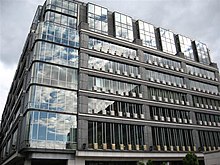
Warsaw's first stock exchange was established in 1817 and continued trading until World War II. It was re-established in April 1991, following the end of a communist planned economy and the reintroduction of a free-market economy.[174] Today, the Warsaw Stock Exchange (WSE) is, according to many indicators,[175] the largest market in the region, with 433 companies listed and total capitalisation of 1 trillion PLN as of 26 November 2020.[176] From 1991 until 2000, the stock exchange was, ironically, located in the building previously used as the headquarters of the communist Polish United Workers' Party (PZPR).[177]
Industry
The most prominent industries and industrial sectors include high-tech, electrotechnical, chemical, cosmetic, construction, food processing, printing, metallurgy, machinery and clothing. The majority of production plants and facilities are concentrated within the WOP Warsaw Industrial Precinct (Warszawski Okręg Przemysłowy) which is situated around the city's peripheral localities such as Praga, Pruszków, Sochaczew, Piaseczno, Marki and Żyrardów.[178] Warsaw has developed a particularly strong retail market/sector, representing around 13% of the total retail stock in the country.[179]
Following World War II, the authorities decided that the city will be transformed into a major centre for
Tourism

The estimated number of tourist arrivals to Warsaw in 2022 was over 9 million. Most tourists came from the
144,220 people used Warsaw Tourist Lines in 2022 - almost 14,000 more than previous year. In the summer, Warsaw residents and tourists could ude ferries across the Vistula, a ship to Serock, bus and tram lines operated with historic rolling stock, and a narrow-gauge railway. The most popular attraction among tourists was the Royal Łazienki Museum, which was visited by 5,265,110 tourists.[170]
Warsaw is an important center for conferences and congresses. The Warsaw Convention Bureau collected information on 9,000 events in 2022, which gathered a total of 1,240,467 participants in Warsaw.[170]
Media and film
Warsaw is the media centre of Poland, and the location of the main headquarters of
Since May 1661 the first Polish newspaper, the Polish Ordinary Mercury, was printed in Warsaw. The city is also the printing capital of Poland with a wide variety of domestic and foreign periodicals expressing diverse views, and domestic newspapers are extremely competitive. Rzeczpospolita, Gazeta Wyborcza and Dziennik Polska-Europa-Świat, Poland's large nationwide daily newspapers,[181] have their headquarters in Warsaw.
Since World War II, Warsaw has been the most important centre of film production in Poland. Among the movie companies are TOR, Czołówka, Zebra and
Education
Higher education in Warsaw Name and year established
|
Warsaw holds some of the finest institutions of higher education in Poland. It is home to four major universities and over 62 smaller schools of higher education.[185] The overall number of students of all grades of education in Warsaw is almost 500,000 (29.2% of the city population; 2002). The number of university students is over 280,000.[186] Most of the reputable universities are public, but in recent years there has also been an upsurge in the number of private universities.

The
Warsaw has numerous libraries, many of which contain vast collections of historic documents. The most important library in terms of historic document collections is the National Library of Poland. The library holds 8.2 million volumes in its collection.[195] Formed in 1928,[196] it sees itself as a successor to the Załuski Library, the biggest in Poland and one of the first and biggest libraries in the world.[196][197]
Another important library – the University Library, founded in 1816,[198] is home to over two million items.[199] The building was designed by architects Marek Budzyński and Zbigniew Badowski and opened on 15 December 1999.[200] It is surrounded by green. The University Library garden, designed by Irena Bajerska, was opened on 12 June 2002. It is one of the largest roof gardens in Europe with an area of more than 10,000 m2 (110,000 sq ft), and plants covering 5,111 m2 (55,010 sq ft).[201] As the university garden it is open to the public every day.[201]
- Higher education institutions in Warsaw
-
Warsaw University of Technology main building
-
Warsaw University Library
-
Warsaw School of EconomicsCampus
-
Faculty of Journalism, University of Warsaw
Transport
Warsaw is a considerable transport hub linking

The table presents statistics on public transport in Warsaw.[204][202]
| System | Stations / Lines / Net length | Annual ridership | Operator / Notes |
|---|---|---|---|
| Metro | 39 / 2 / 41 km (25 mi) | 199,974,995 (2023) | ZTM / Underground rail system
|
| Trams | 538 / 24 / 133 km (83 mi) | 248,903,710 (2023) | ZTM / Lines marked with one- or dwo-digit number
|
| Bus | 3227 / 301 / 3,024 km (1,879 mi) | 452,220,927 (2023) | ZTM / Extensive services in all boroughs / 41 Night lines / Lines marked with three-digit number
|
Fast Urban Railway
|
198 / 9 / 116 km (72 mi) | 15,161,224 (2023) | ZTM / Overground rapid transit rail system
|
| Koleje Mazowieckie | 45 stations within the city | 36,018,918 (2023) | KM / Regional carrier / Within the city limits a common ticket with other means of public transport / Number of passengers using stations located in Warsaw |
| Commuter Railway | 2 / 28 / 33 km (21 mi) | 3,516,550 (2023) | WKD / Operates on a separate railway line |
Warsaw lacks a complete
The A2 motorway opened in June 2012, stretches west from Warsaw and is a direct motorway connection with Łódź, Poznań and ultimately with Berlin.

The city has two
Public transport also extends to
Long distance and intercity trains are operated by Polish State Railways (PKP). There are also some suburban bus lines run by private operators.[209] Bus service covers the entire city, with approximately 256 routes totalling above 3,000 kilometres (1,900 mi), and with some 1,700 vehicles.
The first section of the Warsaw Metro was opened in 1995 initially with a total of 11 stations.[210] As of 2024, it has 39 stations running a distance of approximately 41 km (25 mi).[211]
The main railway station is Warszawa Centralna serving both domestic traffic to almost every major city in Poland, and international connections. There are also five other major railway stations and a number of smaller suburban stations.
- Public transport in Warsaw
-
Warszawa Centralna
-
Fast Urban Railway at Chopin Airportstation
-
Koleje Mazowieckie trains at Warszawa Wschodnia
-
Veturilo bicycle rack at Oboźna Street
-
Entrace to the metro station
Culture
Music and theatre

Thanks to numerous musical venues, including the
Warsaw is also considered one of the European hubs of underground electronic music with a very attractive house and techno music scene.[213]
Warsaw is home to over 30 major theatres spread throughout the city, including the National Theatre (founded in 1765) and the Grand Theatre (established 1778).[214]
Warsaw also attracts many young and off-stream directors and performers who add to the city's theatrical culture. Their productions may be viewed mostly in smaller theatres and Houses of Culture (Domy Kultury), mostly outside Śródmieście (Central Warsaw). Warsaw hosts the International Theatrical Meetings.
From 1833 to the outbreak of World War II, Plac Teatralny (Theatre Square) was the country's cultural hub and home to the various theatres.[215] Plac Teatralny and its environs was the venue for numerous parades, celebrations of state holidays, carnival balls and concerts.
The main building housed the
Nearby, in Ogród Saski (the Saxon Garden), the Summer Theatre was in operation from 1870 to 1939,[216] and in the inter-war period, the theatre complex also included Momus, Warsaw's first literary cabaret, and Leon Schiller's musical theatre Melodram. The Wojciech Bogusławski Theatre (1922–26) was the best example of "Polish monumental theatre". From the mid-1930s, the Great Theatre building housed the Upati Institute of Dramatic Arts – the first state-run academy of dramatic art, with an acting department and a stage directing department.[215]
Museums and art galleries
Museums in Warsaw
|
There are over 60 museums and galleries in Warsaw which are accessible to the public.
The collections of
The famous Copernicus Science Centre is an interactive science museum containing over 450 exhibits, enabling visitors to carry out experiments and discover the laws of science for themselves. Warsaw does not have a natural history museum. Yet, it hosts small museums of Evolution and the Earth, which play a similar role.
Holding Poland's largest private collection of art, the
along with some copies of masterpieces of European painting.A fine tribute to the fall of Warsaw and
The 17th century Royal
28 September 2023 the opening of the new building of the Museum of Polish History located at the Warsaw Citadel took place.
The city also possesses some oddities such as the Neon Museum, the Museum of Caricature,[224] the Museum of John Paul II and Primate Wyszyński, the Legia Warsaw Museum, and a Motorisation Museum in Otrębusy.[225]
- Museums in Warsaw
-
POLIN Museum of the History of Polish Jews opened in 2013
-
The 17th-century Ostrogski Castle houses the Chopin Museum.
-
Marie Curie Museum, housed in the tenement house where she was born
Cuisine and food
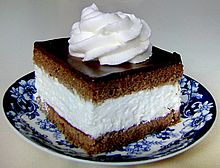
Warsaw's culinary tradition was shaped by its once multicultural population; its cuisine is distinct from that of other cities and towns in Poland.
Much like

Restaurants offering authentic Polish cuisine are concentrated around the Old Town district. Various spit cakes of Czech or Hungarian origin (kürtőskalács and trdelník) are also sold primarily in the Old Town.[232] Hala Koszyki is a popular meeting place in Warsaw noted for its food hall.[233]
In the 20th century, Warsaw was famed for its state-owned
Gourmet and haute cuisine establishments are situated in the vicinity of the downtown area or in the Frascati neighbourhood. Thirteen Varsovian restaurants were appreciated by the Michelin Guide, with two receiving a michelin star in 2019.[235][236]
In 2021, National Geographic named Warsaw one of the top cities for vegans in Europe. Śródmieście Południowe (Southern Downtown) and its "hipster food culture" was singled out as the epicenter.[237]
Events

Several commemorative events take place every year, notably the Orange Warsaw Festival featuring music concerts. One of the more popular events is the procession of the Three Wise Men (in Polish known as the Three Kings) on Epiphany, shortly after the New Year. Paper crowns are usually worn by spectators throughout the day. The event, which runs along the Royal Route, is attended by Warsaw's highest officials and by the Polish president who resides nearby.[238][239]
Gatherings of thousands of people on the banks of the Vistula on Midsummer's Night for a festival called Wianki (Polish for Wreaths) have also become a tradition and a yearly event in the programme of cultural events in Warsaw.[240][241] The festival traces its roots to a peaceful pagan ritual where maidens would float their wreaths of herbs on the water to predict when they would be married, and to whom.[240] By the 19th century this tradition had become a festive event, and it continues today.[240] The city council organize concerts and other events.[241] Each Midsummer's Eve, apart from the official floating of wreaths, jumping over fires, and looking for the fern flower, there are musical performances, dignitaries' speeches, fairs and fireworks by the river bank.[241]
Warsaw Multimedia Fountain Park is located in an enchanting place, near the Old Town and the Vistula. The 'Water – Light – Sound' multimedia shows take place each Friday and Saturday from May until September at 9.30 pm (May and – 9 October pm). On other weekdays, the shows do not include lasers and sound.
The Warsaw Film festival, an annual festival that takes place every October.[242] Films are usually screened in their original language with Polish subtitles and participating cinemas include Kinoteka (Palace of Science and Culture), Multikino at Golden Terraces and Kultura. Over 100 films are shown throughout the festival, and awards are given to the best and most popular films.[242]
Warsaw Mermaid

The mermaid (syrenka) is Warsaw's symbol[243] and can be found on statues throughout the city and on the city's coat of arms. This imagery has been in use since at least the mid-14th century.[244] The oldest existing armed seal of Warsaw is from the year 1390, consisting of a round seal bordered with the Latin inscription Sigilium Civitatis Varsoviensis (Seal of the city of Warsaw).[245] City records as far back as 1609 document the use of a crude form of a sea monster with a female upper body and holding a sword in its claws.[246] In 1653 the poet Zygmunt Laukowski asks the question:
Warsaw of strong walls; why was the emblem Mermaid with sharp sword, given you by the kings?
— Zygmunt Laukowski[247]

The Mermaid Statue stands in the very centre of Old Town Square, surrounded by a fountain. Due to vandalism, the original statue had been moved to the grounds of the Museum of Warsaw – the statue in the square is a copy. This is not the only mermaid in Warsaw. Another is located on the bank of the Vistula River near Świętokrzyski Bridge and another on Karowa Street.
The origin of the legendary figure is not fully known. The best-known legend, by Artur Oppman, is that long ago two of Triton's daughters set out on a journey through the depths of the oceans and seas. One of them decided to stay on the coast of Denmark and can be seen sitting at the entrance to the port of Copenhagen. The second mermaid reached the mouth of the Vistula River and plunged into its waters. She stopped to rest on a sandy beach by the village of Warszowa, where fishermen came to admire her beauty and listen to her beautiful voice. A greedy merchant also heard her songs; he followed the fishermen and captured the mermaid.[248]
Another legend says that a mermaid once swam to Warsaw from the Baltic Sea for the love of the Griffin, the ancient defender of the city, who was killed in a struggle against the Swedish invasions of the 17th century. The mermaid, wishing to avenge his death, took the position of defender of Warsaw, becoming the symbol of the city.[248]
Every member of the
Sports
On 9 April 2008, the Mayor of Warsaw, Hanna Gronkiewicz-Waltz, obtained from the mayor of Stuttgart Wolfgang Schuster a challenge award – a commemorative plaque awarded to Warsaw as the European capital of Sport in 2008.[251]

The
There are many sports centres in the city as well. Most of these facilities are swimming pools and sports halls, many of them built by the municipality in the past several years. The main indoor venue is

The best of the city's swimming centres is at Wodny Park Warszawianka, 4 km (2 mi) south of the centre at Merliniego Street, where there's an Olympic-sized pool as well as water slides and children's areas.[255]
From the Warsovian football teams, the most famous is
Their local rivals,
Famous people
One of the most famous people born in Warsaw was
Russian Jewish poet and essayist Osip Mandelstam, one of the foremost members of the Acmeist school of poetry was born in Warsaw while it was part of the Russian Empire. Other notables include Samuel Goldwyn, the founder of Goldwyn Pictures, mathematician Benoit Mandelbrot, physicist Joseph Rotblat, biochemist Casimir Funk, and Moshe Prywes, an Israeli physician who was the first President of Ben-Gurion University of the Negev. Warsaw was the beloved city of Isaac Bashevis Singer, which he described in many of his novels:[263] "Warsaw has just now been destroyed. No one will ever see the Warsaw I knew. Let me just write about it. Let this Warsaw not disappear forever", he wrote.[264] Notable sportspeople born in Warsaw include footballer Robert Lewandowski[265] and tennis player Iga Świątek.[266]
International relations
Twin towns and sister cities
Former twin towns:
Partnership and friendship
Warsaw also cooperates with:[267]
 Budapest, Hungary (2005)
Budapest, Hungary (2005) Buenos Aires, Argentina (1992)[269]
Buenos Aires, Argentina (1992)[269] Coventry, United Kingdom (1957)[270]
Coventry, United Kingdom (1957)[270] The Hague, Netherlands (1991)
The Hague, Netherlands (1991) Hamamatsu, Japan (1990)
Hamamatsu, Japan (1990) Harbin, China (1993)
Harbin, China (1993) Île-de-France, France (1990)
Île-de-France, France (1990) Istanbul, Turkey (1991)
Istanbul, Turkey (1991) Madrid, Spain (1981)[271]
Madrid, Spain (1981)[271] Manila, Philippines (2006)
Manila, Philippines (2006) Oslo, Norway (2006)
Oslo, Norway (2006) Paris, France (1999)[272]
Paris, France (1999)[272] Saint-Étienne, France (1995)
Saint-Étienne, France (1995) Toronto, Canada (1990)
Toronto, Canada (1990) Vienna, Austria (1991)
Vienna, Austria (1991) Yerevan, Armenia (2013)[273]
Yerevan, Armenia (2013)[273]
Former partner cities:
 Saint Petersburg, Russia (1997–2022)[268]
Saint Petersburg, Russia (1997–2022)[268]
See also
- C40 Cities Climate Leadership Group
- Destruction of Warsaw
- Architecture of Warsaw
- Legia Warsaw
- List of tallest buildings in Warsaw
- List of honorary citizens of Warsaw
- Street names of Warsaw
- Tourism in Poland
- Various battles of Warsaw
- Various treaties of Warsaw
- Warsaw concentration camp
- Warsaw subdialect
- Warsaw Fire Guard
Notes
- Latin: Varsovia or Varsavia
- ^ Polish: miasto stołeczne Warszawa [ˈmjastɔ stɔˈwɛt͡ʂnɛ varˈʂava] ⓘ, abbreviation: m.st. Warszawa.
References
- ^ Rayasam, Renuka (10 May 2016). "This once-dark city is becoming the darling of Europe". BBC.
- ^ a b "GUS - Bank Danych Lokalnych". bdl.stat.gov.pl. Archived from the original on 22 September 2022. Retrieved 21 September 2022.
- ^ "Population on 1 January by age, sex and NUTS 2 region". Eurostat. Retrieved 29 February 2024.
- ^ "EU regions by GDP, Eurostat". ec.europa.eu.
- ^ "Gross domestic product (GDP) at current market prices by NUTS 3 regions". ec.europa.eu.
- ^ "EXPENDITURE OF THE CAPITAL CITY OF WARSAW BUDGET BY TYPE" (PDF). Archived from the original (PDF) on 22 February 2023. Retrieved 8 January 2023.
- ^ "Journal of Laws of Poland, position 1817, 2018". Archived from the original on 30 August 2021. Retrieved 30 August 2021.
- ^ "Warsaw". goeuro2012.com. Archived from the original on 3 June 2008. Retrieved 15 July 2008.
- ^ "The World According to GaWC 2020". GaWC – Research Network. Globalization and World Cities. Archived from the original on 24 August 2020. Retrieved 31 August 2020.
- ^ "Coat of Arms and Colours of the Capital City of Warsaw". bip.warszawa.pl. Archived from the original on 23 April 2016. Retrieved 14 January 2009.
- ^ Czerkawski, Andrzej; Jurga, Tadeusz (1969). Dla ciebie ojczyzno. Sport i Turystyka. p. 435. Archived from the original on 8 January 2022. Retrieved 22 November 2020.
ORDER OF VALOUR "VIRTUTI MILITARI", FIFTH CLASS Capital City of Warsaw 1940 To the inhabitants of the Capital City of Warsaw – in recognition of their heroism and unshakable bravery in the struggle with the Nazi aggressor.
- ^ "Warsaw – Phoenix City Rebuilt From the Ashes". youramazingplaces.com. 26 December 2014. Archived from the original on 24 December 2015. Retrieved 17 September 2015.
- ^ "Warsaw Stock Exchange, Poland, stocks, investing online – Fio bank". Archived from the original on 9 April 2017. Retrieved 9 April 2017.
- ^ "Warsaw: The Region's Key Market". Warsaw Capital Market Summit 2015. Archived from the original on 8 December 2015. Retrieved 29 October 2015.
- ^ "The Grand Theater in Warsaw: one of the largest theatres in Europe and one of the biggest stages in the world –". communications-unlimited.nl. 27 May 2016. Archived from the original on 6 April 2020. Retrieved 14 November 2017.
- ^ WorldlyTraveller (10 May 2016). "Warsaw, City of Classical Music and Varied Architecture in Poland – Worldly Resort". Archived from the original on 10 May 2016. Retrieved 9 April 2017.
- ^ Skoczeń, Paulina. "Warsaw is a green city". Archived from the original on 9 April 2017. Retrieved 9 April 2017.
- ^ Charly Wilder (23 December 2015). "36 Hours in Warsaw, Poland". The New York Times. Archived from the original on 28 December 2015. Retrieved 29 December 2015.
- ^ Samuel Bogumił Linde, Slownik jẹzyka polskiego (1808)
- ^ Julian Weinberg, Polacy w Rodzinie Sławian (1878)
- ^ "Online Etymology Dictionary". etymonline.com. Archived from the original on 23 September 2017. Retrieved 26 May 2017.
- from the original on 2 December 2017. Retrieved 26 May 2017 – via revije.ff.uni-lj.si.
- ISBN 83-04-02436-5.
- ^ "The Warsaw Mermaid". Archived from the original on 16 June 2013. Retrieved 11 February 2008.
- ^ "Historia Warszawy" (in Polish). Archived from the original on 13 May 2010. Retrieved 11 February 2008.
- ^ "Ustawa o ustroju miasta stołecznego Warszawy". prawo.lex.pl (in Polish). Archived from the original on 1 January 2007. Retrieved 15 July 2008.
- ^ a b c d e f g h i j "Warsaw's history". e-warsaw.pl. Archived from the original on 9 November 2009. Retrieved 24 July 2008.
- ^ ISBN 83-03-00702-5.
- ISBN 0-19-925339-0.
- ^ "Fragment szaty książąt mazowieckich". Muzeum Warszawy. Archived from the original on 8 August 2020. Retrieved 21 June 2020.
- ^ "Mało czarujący koniec Piastów mazowieckich – Kwartalnik Przekrój". przekroj.pl. 20 February 2018. Archived from the original on 28 October 2020. Retrieved 19 June 2020.
- ^ Neal Ascheron. "The Struggles for Poland". halat.pl. Archived from the original on 21 October 2013. Retrieved 24 July 2008.
- ISBN 83-89632-04-7.
- ^ "Ogród Saski" (PDF) (in Polish). Archived (PDF) from the original on 8 December 2020. Retrieved 27 November 2020.
- ^ "The Bygone Warsaw". 14 March 2008. Archived from the original on 14 March 2008. Retrieved 18 November 2017.
- ISBN 83-223-2245-3.
- ^ John Stanley (March–June 2004). "Literary Activities and Attitudes in the Stanislavian Age in Poland (1764–1795): A Social System?". Archived from the original on 14 May 2011. Retrieved 23 April 2009 – via Find Articles.
- ISBN 90-804114-4-2. Archivedfrom the original on 8 January 2022. Retrieved 25 October 2015.
- ^ Crowley, David (2003). Warsaw. London: Reaktion Books. p. 10.
- OCLC 1163562236.
- ^ (in French) Zbigniew Naliwajek. Romain Rolland et la littérature polonaise Archived 1 March 2012 at the Wayback Machine. Revue de littérature comparée 3/2003 (n°307), p. 325-338.
- ^ a b Augustin P. O'Brien (1864). Petersburg and Warsaw: Scenes Witnessed During a Residence in Poland and Russia in 1863–64. R. Bentley. Archived from the original on 8 January 2022. Retrieved 28 January 2009.
- ^ "Wyborcza.pl". warszawa.wyborcza.pl. Archived from the original on 22 June 2020. Retrieved 21 June 2020.
- ^ "Wola przemysł" (PDF) (in Polish). Archived (PDF) from the original on 23 September 2020. Retrieved 21 June 2020.
- ^ "Wyborcza.pl". warszawa.wyborcza.pl. Archived from the original on 22 June 2020. Retrieved 21 June 2020.
- ^ "Żydowska Warszawa. Współcześnie". 12 April 2018. Archived from the original on 22 June 2020. Retrieved 21 June 2020.
- ^ "Visualizing the 1897 Census in Pie Charts – Russian History Blog". russianhistoryblog.org. Archived from the original on 27 September 2018. Retrieved 27 September 2018.
- ISBN 9780816658862. Archivedfrom the original on 1 January 2016. Retrieved 25 October 2015.
- ^ Adam Zamoyski, Warsaw 1920: Lenin's Failed Conquest of Europe (2008)
- ^ "Powierzchnia Warszawy w latach 1921-2008". Archived from the original on 21 June 2020. Retrieved 19 June 2020.
- ^ M.M. (2 August 2006). "Warsaw: A Last Glimpse". warsawvoice.pl. Archived from the original on 26 September 2006. Retrieved 29 July 2008.
- ^ a b c d "Warsaw". United States Holocaust Memorial Museum. Archived from the original on 16 March 2010. Retrieved 29 July 2008.
- ^ Snyder, Timothy (2010). Bloodlands. London: The Bodley Head. p. 280.
- ^ a b c "The Warsaw Ghetto Uprising". United States Holocaust Memorial Museum. Archived from the original on 17 May 2008. Retrieved 29 July 2008.
- ^ "The Warsaw Ghetto Uprising". aish.com. Archived from the original on 23 June 2008. Retrieved 29 July 2008.
- ^ "Warsaw Uprising". Encyclopædia Britannica. Archived from the original on 16 December 2009. Retrieved 5 February 2009. Hoping to gain control of Warsaw before the Red Army could "liberate" it, the Home Army followed the Soviet suggestion to revolt.
- ^ a b c d e f "Warsaw Uprising of 1944". warsawuprising.com. Archived from the original on 3 August 2018. Retrieved 14 July 2008.
- ^ Borkiewicz, Adam (1957). Powstanie warszawskie 1944: zarys działań natury wojskowej. Warsaw: PAX.
- ^ "Warsaw Uprising of 1944". warsawuprising.com. Archived from the original on 29 September 2018. Retrieved 14 July 2008.
- ISBN 0-226-00443-0. Archivedfrom the original on 8 January 2022. Retrieved 17 September 2020.
The Soviet troops, ordered by Stalin to wait until the Germans had destroyed the remnants of Polish resistance, then moved into what was left of Warsaw, flushed out the remaining Germans, and proclaimed themselves liberators of the city.
- ^ "Warsaw's lost architecture portrayed in miniature". The Times of Israel. Archived from the original on 22 March 2017. Retrieved 11 June 2017.
- ^ "Pałac Leopolda Kronenberga". warszawa1939.pl (in Polish). Archived from the original on 6 December 2008. Retrieved 29 July 2008.
- ISBN 9788370221607. Archivedfrom the original on 5 April 2023. Retrieved 20 March 2023.
- ^ Ziemichód, Przemysław (2 June 2017). "Pałac Kultury i Nauki – najmniej lubiany symbol Warszawy". Warszawa Nasze Miasto. Archived from the original on 22 June 2020. Retrieved 21 June 2020.
- ISBN 18-61891-79-2. Archivedfrom the original on 18 August 2021. Retrieved 22 November 2020.
- ^ a b c "Pope in Warsaw". destinationwarsaw.com. Archived from the original on 2 February 2009. Retrieved 5 February 2009.
- ^ "Warsaw Metro". Railway Technology.
- ^ UK, DVV Media. "Warszawa opens second metro line". railwaygazette.com. Archived from the original on 18 April 2015. Retrieved 13 April 2015.
- ^ "Inforegio - 3 subsequent stations of Warsaw's Metro Line 2 up and running!". ec.europa.eu.
- ^ Tilles, Daniel (14 February 2023). "Warsaw unveils plans to more than double size of metro". Notes From Poland.
- ^ "The Impact of Poland's EU Accession on its Economy" (PDF). files.ethz.ch.
- ^ "Attracting foreign investments". polandtrade.com.hk. Archived from the original on 8 November 2007. Retrieved 24 July 2008.
- ^ "The National Stadium in Warsaw". poland2012.net. Retrieved 24 July 2008.
- ^ "WARSAW CLIMATE CHANGE CONFERENCE - NOVEMBER 2013". unfccc.int. Archived from the original on 26 September 2023. Retrieved 25 September 2023.
- ^ "NATO summit, Warsaw, Poland, 8-9 July 2016". consilium.europa.eu. Archived from the original on 26 September 2023. Retrieved 25 September 2023.
- ^ "'Time stopped': Ukrainians long to go home as war drags on". AP News. 22 August 2022. Archived from the original on 3 April 2023. Retrieved 26 September 2023.
- ^ "Geography of Warsaw". geography.howstuffworks.com. Archived from the original on 12 July 2011. Retrieved 27 February 2009.
- ^ "City: Introduction and characteristics" (PDF). Infrastuktura – Miasto Stołeczne Warszawa. Archived from the original on 8 January 2022. Retrieved 10 March 2019.
- ^ "Warsaw, Poland Köppen Climate Classification (Weatherbase)". Weatherbase. Archived from the original on 22 January 2021. Retrieved 10 March 2019.
- ^ a b "Average Temperatures in Warsaw, Poland Temperature". warsaw.climatemps.com. Archived from the original on 30 August 2017. Retrieved 20 October 2017.
- ISBN 9789811013911. Archivedfrom the original on 8 January 2022. Retrieved 22 November 2020.
- PMID 27498882.
- ^ "Warsaw (12375) - WMO Weather Station". NOAA. Retrieved 29 December 2018.[dead link] Alt URL
- ^ Alex (10 May 2015). "Climates classification by Wincenty Okołowicz". Vivid Maps. Archived from the original on 22 March 2019. Retrieved 10 March 2019.
- ^ "European Cities With Driest Weather – Current Results". www.currentresults.com. Archived from the original on 11 April 2020. Retrieved 12 March 2019.
- ^ "Średnia dobowa temperatura powietrza". Normy klimatyczne 1991-2020 (in Polish). Institute of Meteorology and Water Management. Archived from the original on 3 December 2021. Retrieved 20 January 2022.
- ^ "Średnia minimalna temperatura powietrza". Normy klimatyczne 1991-2020 (in Polish). Institute of Meteorology and Water Management. Archived from the original on 15 January 2022. Retrieved 20 January 2022.
- ^ "Średnia maksymalna temperatura powietrza". Normy klimatyczne 1991-2020 (in Polish). Institute of Meteorology and Water Management. Archived from the original on 15 January 2022. Retrieved 20 January 2022.
- ^ "Miesięczna suma opadu". Normy klimatyczne 1991-2020 (in Polish). Institute of Meteorology and Water Management. Archived from the original on 9 January 2022. Retrieved 20 January 2022.
- ^ "Liczba dni z opadem >= 0,1 mm". Normy klimatyczne 1991-2020 (in Polish). Institute of Meteorology and Water Management. Archived from the original on 15 January 2022. Retrieved 20 January 2022.
- ^ "Średnia grubość pokrywy śnieżnej". Normy klimatyczne 1991-2020 (in Polish). Institute of Meteorology and Water Management. Archived from the original on 15 January 2022. Retrieved 20 January 2022.
- ^ "Liczba dni z pokrywą śnieżna > 0 cm". Normy klimatyczne 1991-2020 (in Polish). Institute of Meteorology and Water Management. Archived from the original on 21 January 2022. Retrieved 20 January 2022.
- ^ "Średnia suma usłonecznienia (h)". Normy klimatyczne 1991-2020 (in Polish). Institute of Meteorology and Water Management. Archived from the original on 15 January 2022. Retrieved 20 January 2022.
- ^ "WARSZAWA Absolutna temperatura maksymalna" (in Polish). Meteomodel.pl. 6 April 2018. Archived from the original on 19 March 2022. Retrieved 20 January 2022.
- ^ "WARSZAWA Absolutna temperatura minimalna" (in Polish). Meteomodel.pl. 6 April 2018. Archived from the original on 19 March 2022. Retrieved 20 January 2022.
- ^ "WARSZAWA Średnia wilgotność" (in Polish). Meteomodel.pl. 6 April 2018. Archived from the original on 19 March 2022. Retrieved 20 January 2022.
- ^ "Warsaw, Poland - Detailed climate information and monthly weather forecast". Weather Atlas. Yu Media Group. Archived from the original on 12 February 2019. Retrieved 2 July 2019.
- ^ "Climate & Weather Averages in Warsaw, Poland". Time and Date. Archived from the original on 24 July 2022. Retrieved 24 July 2022.
- ^ "Meteomodel. Dane. Średnie i sumy miesięczne". meteomodel.pl. 30 July 2022. Archived from the original on 19 September 2022. Retrieved 21 January 2022.
- ^ "Warsaw, Poland – Monthly weather forecast and Climate data". Weather Atlas. Archived from the original on 12 February 2019. Retrieved 10 February 2019.
- ^ ISBN 9788361590361. Archivedfrom the original on 16 August 2021. Retrieved 22 November 2020 – via Google Books.
- ^ Cztery wieki Mazowsza: Szkice z dziejów, 1526-1914. Nasza Księgarnia. 1968. Archived from the original on 8 January 2022. Retrieved 21 June 2020.
- ^ Galloway, Lindsey (5 March 2018). "The secrets hiding in Warsaw, the Paris of the East". www.bbc.com. BBC. Archived from the original on 31 May 2023. Retrieved 3 June 2023.
- ^ "A town house of the Burbach family". eGuide / Treasures of Warsaw on-line. Archived from the original on 28 May 2007. Retrieved 23 February 2009.
- ^ Redakcja, przez (21 January 2020). "Wyremontują kolumnę Zygmunta III Wazy za ponad 230 tys. złotych!". Archived from the original on 22 June 2020. Retrieved 21 June 2020.
- ^ a b c "Warszawski barok". edukacjamedialna.edu.pl. Retrieved 21 January 2024.
- ^ Jerzy S. Majewski (11 December 2023). "Architektura warszawska pierwszej połowy XIX w." varsavianista.pl. Retrieved 21 January 2024.
- ^ Ryszard Mączewski (21 December 2023). "Rozwój Warszawy w drugiej połowie XIX w." varsavianista.pl. Retrieved 21 January 2024.
- ^ Jerzy S. Majewski (29 December 2023). "Architektura Warszawy lat 20. XX w." varsavianista.pl. Retrieved 21 January 2024.
- ^ "Politechnika Warszawska". warszawa1939.pl (in Polish). Archived from the original on 30 August 2011. Retrieved 27 February 2009.
- ^ "As good as new". The official website of the City of Warsaw. 1 March 2006. Archived from the original on 20 May 2008.
- ^ Sampo Ruoppila (2004). Processes of Residential Differentiation in Socialist Cities (PDF). European Journal of Spatial Development. pp. 9–10. Archived from the original (PDF) on 19 August 2010. Retrieved 10 October 2010.
- ^ "Warszawa: Modny Plac Zbawiciela, orientalne restauracje i wielkie zakupy". podroze.se.pl. Archived from the original on 21 June 2020. Retrieved 19 June 2020.
- ^ "Metropolitan Life". warsawvoice.pl. 4 February 2004. Archived from the original on 25 May 2006. Retrieved 23 February 2009.
- ^ James Newman, ed. (2015). "Europes Top Skyscraper Cities". The Top 500. SkyscraperNews.com. Archived from the original on 24 September 2015. Retrieved 20 October 2015.
- ^ "Warsaw – The Skyscraper Center". Archived from the original on 16 December 2013. Retrieved 18 November 2013.
- ^ "Palace". wilanow-palac.art.pl. Archived from the original on 17 February 2012. Retrieved 21 February 2008.
- ^ a b c "Warsaw Judaica". um.warszawa.pl. Archived from the original on 5 August 2007. Retrieved 26 January 2010.
- ^ "Heroic City". um.warszawa.pl. Archived from the original on 4 July 2013. Retrieved 26 January 2010.
- ^ James Ramsay Montagu Butler; Norman Henry Gibbs; J. M. A. Gwyer; John Patrick William Ehrman; Michael Eliot Howard (1976). "History of the Second World War; United Kingdom military series 5". In James Ramsay Montagu Butler (ed.). Grand strategy. H. M. Stationery Office. p. 369.
- ^ "Church of the Holy Cross". eGuide / Treasures of Warsaw on-line. Archived from the original on 18 February 2006. Retrieved 23 February 2009.
- ^ "Frédéric Chopin Monument". eGuide / Treasures of Warsaw on-line. Archived from the original on 28 May 2007. Retrieved 23 February 2009.
- ^ "Polish Girlhood (1867–1891)". aip.org. American Institute of Physics. Archived from the original on 2 November 2011. Retrieved 25 February 2009.
- ^ "The Radium Institute (1919–1934)". aip.org. American Institute of Physics. Archived from the original on 28 October 2011. Retrieved 25 February 2009.
- ^ a b c "Warszawskie cmentarze, czyli historia Polski i Warszawy w pigułce". Retrieved 19 January 2024.
- ^ "Stare Powązki – wszystkie groby policzone i opisane". Retrieved 19 January 2024.
- ^ a b "Ważne pomniki w Warszawie". Retrieved 19 January 2024.
- ^ "WARSZAWSKIE POMNIKI". Retrieved 19 January 2024.
- ^ Warsaw Tourist Office. "Parks & Gardens". warsawtour.pl. Archived from the original on 12 January 2010. Retrieved 23 February 2009. "Warsaw is a green city. Almost a quarter of its area is comprisedof fields, parks, green squares and lush gardens, making Warsaw a European metropolis that truly offers its visitors a breath of fresh air."
- ^ "Parki i lasy Warszawy". um.warszawa.pl (in Polish). Archived from the original on 16 May 2016. Retrieved 25 February 2009.
- ^ "Nowa Pomarańczarnia". ePrzewodnik / Perełki Warszawy on-line (in Polish). Archived from the original on 8 February 2006. Retrieved 24 February 2009.
- ^ "Park Praski". zielona.um.warszawa.pl (in Polish). Archived from the original on 13 March 2010. Retrieved 19 April 2011. Powstał w latach 1865–1871, według projektu Jana Dobrowolskiego, na prawym brzegu Wisły.
- ^ "Nature reserves as a refuge of Grifola frondosa (DICKS.: FR.) GRAY in central Poland". bpn.com.pl. Archived from the original on 12 August 2011. Retrieved 24 February 2009.
- ^ "Kayaking on the Vistula". warsawvoice.pl. 30 August 2006. Archived from the original on 26 September 2006. Retrieved 24 February 2009.
- ^ a b c "Warsaw Zoo". zoo.waw.pl. Archived from the original on 28 April 2019. Retrieved 24 February 2009.
- ^ Warsaw Zoo opened 11 March 1928, on Ratuszowa Street. It was not the first zoological garden in Warsaw; King Jan Sobieski III kept a court menagerie in Wilanów. Several private zoos were also established in Warsaw in the 19th century. "New Zoo Revue". warsawvoice.pl. 24 April 2003. Archived from the original on 18 January 2005. Retrieved 9 May 2009.
- ISBN 0-8493-2100-X. Archivedfrom the original on 13 April 2016. Retrieved 25 October 2015.
- ^ "Migrations Map: Where are migrants coming from? Where have migrants left?". MigrationsMap.net. Archived from the original on 11 February 2016. Retrieved 12 February 2016.
- ISBN 0-299-19464-7. Archivedfrom the original on 10 May 2021. Retrieved 22 November 2020.
- ^ F.A. Brockhaus Verlag Leipzig (1935). Der Grosse Brockhaus: Handbuch des Wissens (in German). Vol. 20 (15th ed.). Brockhaus. p. 25.
- ^ "Narodowości w II RP na przedwojennych wykresach. Gdzie było najmniej Polaków, a gdzie najwięcej?". WielkaHistoria. 27 October 2019. Archived from the original on 23 June 2020. Retrieved 21 June 2020.
- ^ "Przynależność narodowo-etniczna - dane NSP 2021 dla kraju i jednostek podziału terytorialnego". Statistics Poland. 20 December 2023.
{{cite web}}: CS1 maint: url-status (link) - ^ "Warszawa (Mazowieckie) » mapy, nieruchomości, GUS, noclegi, szkoły, regon, atrakcje, kody pocztowe, wypadki drogowe, bezrobocie, wynagrodzenie, zarobki, tabele, edukacja, demografia". Archived from the original on 1 December 2022. Retrieved 8 June 2022.
- ^ "Mapa – Rok". migracje.gov.pl (in Polish). 2024. Archived from the original on 22 October 2023. Retrieved 20 January 2024.
- ^ Dānishgāh-i Tihrān. Faculty of Fine Arts (1990). International Conference on Reconstruction of War-Damaged Areas: 6–16 March 1986 : Faculty of Fine Arts, University of Tehran, Iran. University of Tehran Press. p. 148.
- ^ a b Przemysław Śleszyński; Łukasz Kubiak; Ewa Korcelli-Olejniczak (2020). "Prognoza demograficzna dla Warszawy" (PDF). Retrieved 20 January 2024.
- ^ "Warszawa lubiana przez cudzoziemców. Ilu ich mieszka w stolicy?". gazeta.pl. Archived from the original on 6 January 2017. Retrieved 22 October 2016.
- ^ "Rok wojny i pomocy Ukrainie". um.warszawa.pl. Retrieved 20 January 2021.
- ^ "Warsaw's population has risen 17% due to refugees from Ukraine". notesfrompoland.com. 17 March 2022. Archived from the original on 20 April 2023. Retrieved 20 April 2023.
- ISBN 978-0-307-28057-2.
Today Warsaw is a monocultural city, which is some people's ideal. But before 1939 it was a typically multicultural society. Those were the city's most productive years. We lost that multicultural character during the war.
- ^ Hermann Julius Meyer (1909). Meyers Konversations-Lexikon (in German). Vol. 20 (6th ed.). Leipzig and Vienna: Bibliographisches Institut. p. 388.
- ^ Erich Zechlin (1916). Die Bevölkerungs- und Grundbesitzverteilung im Zartum Polen [The distribution of population and property in tsaristic Poland] (in German). Berlin: Reimer. pp. 82–83.
- ISBN 978-0-7864-5904-9.
- ISBN 978-83-7793-478-4
- ^ "Kult świętych patronów Warszawy". niedziela.pl. Retrieved 20 January 2024.
- ISBN 83-01-08836-2. Archivedfrom the original on 8 January 2022. Retrieved 17 September 2020.
- ^ a b c d e "Administration". e-warsaw.pl. Archived from the original on 18 December 2008. Retrieved 31 January 2009.
- ^ a b Masa Djordjevic (2006). Politics of Urban Development Planning: Building Urban Governance in Post-Socialist Warsaw?. Ashgate Publishing, Ltd. p. 8. Archived from the original on 9 May 2013. Retrieved 10 October 2010.
- ^ "Raport o stanie miasta Warszawa 2022". um.warszawa.pl (in Polish). Warsaw City Hall. Retrieved 21 January 2024.
- ^ Turystyki, Stołeczne Biuro. "WarsawTour – Official Tourist Portal of Warsaw". Archived from the original on 13 April 2005. Retrieved 6 February 2017.
- ^ "Dzielnice". um.warszawa.pl (in Polish). Archived from the original on 1 July 2008. Retrieved 11 July 2008.
- ISBN 978-04-70964-24-8. Archivedfrom the original on 8 January 2022. Retrieved 22 November 2020.
- ^ "Dzielnice Warszawy. Zorganizowana aktywność w środowisku" (PDF). Retrieved 17 January 2024.
- ^ a b "Przegląd Statystyczny Warszawy. 4 kwartał 2022 r." Główny Urząd Statystyczny. Retrieved 17 January 2024.
- ISBN 83-01-08836-2.
- ^ "EU regions by GDP". Eurostat. Archived from the original on 27 February 2023. Retrieved 27 February 2023.
- ^ "PKB w regionach Polski. Warszawa ciągnie polską gospodarkę [MAPA]". forsal.pl. 8 January 2019. Archived from the original on 25 November 2020. Retrieved 27 November 2020.
- ^ "Alpha, Beta and Gamma Cities (Updated 2020); Spotted by Locals Blog". Spotted by Locals. 24 July 2020. Archived from the original on 5 December 2020. Retrieved 27 November 2020.
- ^ "Warsaw among top 10 most attractive European cities for foreign investors". Kafkadesk. 24 June 2019. Archived from the original on 7 December 2020. Retrieved 27 November 2020.
- ^ a b c d "Turystyka w Warszawie - raport 2022" (PDF). City Hall of Warsaw. Retrieved 20 January 2024.
- ^ "Bezrobocie w Warszawie i na Mazowszu bez zmian". Warszawa i Mazowsze - najnowsze wiadomości w RDC. Archived from the original on 5 December 2020. Retrieved 27 November 2020.
- ^ [1] [permanent dead link]
- ^ "Vitkac - Luxury, Premium & Contemporary Shopping". www.vitkac.com. Archived from the original on 25 November 2020. Retrieved 27 November 2020.
- ^ "History". gpw.pl. Archived from the original on 4 September 2012. Retrieved 24 May 2012.
- ^ "Big Chance for the Capital". Warsaw – CEE Financial Hub Conference. warsawvoice.pl. 11 June 2008. Archived from the original on 6 December 2008. Retrieved 28 July 2008.
- ^ "Główny Rynek GPW - Statystyki GPW". Archived from the original on 8 January 2022. Retrieved 27 November 2020.
- ^ "Tourism". poland.gov.pl. Archived from the original on 28 August 2008. Retrieved 28 July 2008.
- ^ "Warszawski Okręg Przemysłowy | hierophant-nox". 20 November 2018. Archived from the original on 6 December 2020. Retrieved 27 November 2020.
- ^ "Understanding Retail Destinations in Warsaw". CBRE. Archived from the original on 27 November 2020. Retrieved 27 November 2020.
- ^ Chris Dziadul (5 October 2007). "A decade of progress". broadbandtvnews.com. Archived from the original on 20 August 2012. Retrieved 14 February 2009.
- ^ "Press release" (PDF). instytut.com.pl. 6 October 2008. Archived from the original (PDF) on 24 February 2009. Retrieved 14 February 2009.
- ^ "Poland film production guide 2008" (PDF). pisf.pl. Archived from the original (PDF) on 24 February 2009. Retrieved 14 February 2009.
- ^ "The Pianist". thepianistmovie.com. Archived from the original on 22 August 2008. Retrieved 14 February 2009.
- ^ "About the National Film Archive". National Film Archive. Archived from the original on 27 September 2017. Retrieved 27 September 2017.
- ^ "Statistical Yearbook of the Republic of Poland 2008" (PDF). stat.gov.pl. Archived from the original (PDF) on 7 February 2009. Retrieved 30 January 2009.
- ^ "Studia w liczbach: Warszawa bije Kraków". miasta.gazeta.pl (in Polish). 10 March 2008. Archived from the original on 19 February 2009. Retrieved 30 January 2009.
- ^ "University of Warsaw". uw.edu.pl. Archived from the original on 18 January 2009. Retrieved 30 January 2009.
- ^ "Why University of Warsaw? | University of Warsaw". en.uw.edu.pl. Archived from the original on 27 July 2023. Retrieved 27 July 2023.
- ^ "The top 29 best universities in Poland: 2023 rankings". www.study.eu. Archived from the original on 27 July 2023. Retrieved 27 July 2023.
- ^ "Ranking Szkół Wyższych Perspektywy 2023". ranking.perspektywy.pl (in Polish). Archived from the original on 28 September 2023. Retrieved 27 July 2023.
- ^ "Warsaw University of Technology (WUT)". onelab.eu. Archived from the original on 20 July 2011. Retrieved 30 January 2009. With over 30,000 students served by over 2,000 professors and instructors, WUT is the largest and the highest-ranking engineering university in Poland.
- ^ "The Fryderyk Chopin University of Music". infochopin.pl. Archived from the original on 24 May 2008. Retrieved 30 January 2009.
- ^ "Warsaw School of Economics – Overview". sgh.waw.pl. Archived from the original on 19 May 2013. Retrieved 30 January 2009.
- ^ "Warsaw University of Life Sciences". sggw.pl. Archived from the original on 27 November 2012. Retrieved 30 January 2009. Warsaw University of Life Sciences – SGGW (WULS – SGGW) is the oldest agricultural academic school in Poland, its history dates back to 1816.
- ^ "Historia zbiorów". bn.org.pl (in Polish). Archived from the original on 1 February 2009. Retrieved 30 January 2009.
- ^ a b Maria Witt (15 September – 15 October 2005). "The Zaluski Collection in Warsaw". The Strange Life of One of the Greatest European Libraries of the Eighteenth Century. FYI France. Archived from the original on 8 February 2008. Retrieved 17 February 2008.
- ^ S.D. Chrostowska. "Polish Literary Criticism Circa 1772: A Genre Perspective". utoronto.ca. Archived from the original on 3 February 2008. Retrieved 17 February 2008.
- ^ "Historia". buw.uw.edu.pl (in Polish). Archived from the original on 7 July 2017. Retrieved 30 January 2009.
- ^ "Zbiory główne". buw.uw.edu.pl (in Polish). Archived from the original on 7 July 2017. Retrieved 30 January 2009.
- ^ "Library building". buw.uw.edu.pl. Archived from the original on 7 July 2017. Retrieved 30 January 2009.
- ^ a b "Garden". buw.uw.edu.pl. Archived from the original on 22 July 2017. Retrieved 30 January 2009.
- ^ a b "Informator statystyczny 2022 - nr XII (grudzień)" (PDF) (in Polish). Warszawski Transport Publiczny. Retrieved 18 January 2024.
- ^ Michal Jeziorski (7 March 2007). "Improving Infrastructure". warsawvoice.pl. Archived from the original on 27 June 2009. Retrieved 28 May 2009.
- ^ "Informator statystyczny 2023 - raport roczny" (PDF) (in Polish). Warszawski Transport Publiczny. Retrieved 18 February 2024.
- ^ "TomTom Traffic Index". TomTom. 2018. Archived from the original on 13 March 2017. Retrieved 6 August 2018.
- ^ "Air passenger transport by main airports in each reporting country". Eurostat. Archived from the original on 9 May 2023. Retrieved 9 May 2023.
- ^ "Pole position: Developing "the most important and largest airport in Central Europe"". airport-business.com. 17 December 2015. Archived from the original on 26 March 2020. Retrieved 30 December 2015.
- ^ "Public transport". e-warsaw.pl. Archived from the original on 10 July 2009. Retrieved 22 August 2008.
- ^ "From monopoly towards market" (PDF). World Bank. Archived (PDF) from the original on 3 March 2016. Retrieved 22 August 2008.
- ^ "A History of Subway Construction". metro.waw.pl. Archived from the original on 10 December 2006. Retrieved 30 January 2009.
- ^ "Technical and Operating Data of the Existing Subway Section". metro.waw.pl. Archived from the original on 17 January 2007. Retrieved 30 January 2009.
- ISBN 1-85828-849-5. Archivedfrom the original on 18 August 2021. Retrieved 22 November 2020.
- ^ "New Europe: Poles dancing". The Guardian. 3 April 2011. Archived from the original on 4 March 2016. Retrieved 12 February 2016.
- ^ "Teatr Wielki-Polish National Opera". Archived from the original on 8 February 2008. Retrieved 11 February 2008.
- ^ a b c "The Theatre's history". teatrwielki.pl. 1998. Archived from the original on 18 April 2008. Retrieved 21 February 2008.
- ^ "Teatr Letni". warszawa1939.pl (in Polish). Archived from the original on 29 June 2009. Retrieved 14 February 2008.
- ^ "Muzea Warszawy". Archived from the original on 6 December 2020. Retrieved 28 November 2020.
- ^ "The Poster Museum at Wilanów". postermuseum.pl. Archived from the original on 25 May 2011. Retrieved 10 February 2009.
- ISBN 978-32-05783-07-7.
Mehrere Gemälde aus dem Berghof befinden sich heute im Nationalmuseum in Warschau. Bordones Venus und Amor etwa (Abb. 100) ebenso wie der Madonnen-Tondo Bugiardinis (Abb. 62) oder ein großes Ruinenbild von Pannini, das in der verglasten Veranda gehangen hatte (Abb. 113).
- ISBN 14-02032-80-3.
- ^ Official name: Museum of John Paul II Collection
- ^ "Museum of John Paul II Collection". muzeummalarstwa.pl. Archived from the original on 29 December 2008. Retrieved 24 February 2009.
- ISBN 978-0-470-15819-7. Archivedfrom the original on 8 January 2022. Retrieved 25 October 2015.
- ^ "Exhibitions". warsaw.com. Archived from the original on 1 February 2009. Retrieved 30 January 2009.
- ^ "Museum history". muzeum-motoryzacji.com.pl. Archived from the original on 29 January 2009. Retrieved 30 January 2009.
- ^ "Królu złoty, gdzie na cymesy? W tych knajpach zjesz prawdziwe, warszawskie potrawy [PRZEWODNIK]". metro.waw. 4 June 2017. Archived from the original on 6 December 2020. Retrieved 28 November 2020.
- ^ a b "Warszawa". Polskie Skarby Kulinarne. Archived from the original on 7 December 2020. Retrieved 28 November 2020.
- ^ a b "Warszawskie specjały - oficjalny portal turystyczny stolicy Polski". Archived from the original on 6 December 2020. Retrieved 28 November 2020.
- ^ "Tradycyjne warszawskie potrawy. Od Cynaderek po Zygmuntówkę". Warszawa Nasze Miasto. 19 April 2016. Archived from the original on 6 December 2020. Retrieved 28 November 2020.
- ^ "Historia kawiarni w Polsce". www.kawiarnie.warszawa.pl. 13 August 2015. Archived from the original on 6 December 2020. Retrieved 28 November 2020.
- ^ "Tłusty czwartek: Warszawska cukiernia Zagoździński wprowadza limity na kupno pączków - Wiadomości". wiadomosci.radiozet.pl. 18 February 2020. Archived from the original on 7 December 2020. Retrieved 28 November 2020.
- ^ "Wyborcza.pl". warszawa.wyborcza.pl. Archived from the original on 10 May 2021. Retrieved 28 November 2020.
- ^ "WARSAW CITY GUIDE: WHERE TO EAT, DRINK, SHOP AND STAY IN POLAND'S CAPITAL". The Independent. 9 July 2018. Archived from the original on 16 November 2021. Retrieved 16 November 2021.
- ^ Zając-Malarowska, Katarzyna (11 April 2017). "Wraca moda na bary mleczne. Reaktywacja Baru Gdańskiego". wawalove.wp.pl. Archived from the original on 7 December 2020. Retrieved 28 November 2020.
- ^ "Wyróżnienia MICHELIN 2019! Pełna lista restauracji - Kraków i Warszawa". Archived from the original on 7 December 2020. Retrieved 28 November 2020.
- ^ "The MICHELIN Plate: Good cooking – the MICHELIN Guide Poland". MICHELIN Guide. Archived from the original on 27 November 2020. Retrieved 28 November 2020.
- ^ Dodd, Liz (6 February 2021). "The eight best cities for vegans". National Geographic. Archived from the original on 28 June 2021. Retrieved 19 June 2021.
- ^ "Orszaki Trzech Króli na ulicach 515 polskich miast". niedziela.pl. Archived from the original on 8 January 2022. Retrieved 28 November 2020.
- ^ "Orszak Trzech Króli / Historia Orszaku Trzech Króli". orszak.org. Archived from the original on 3 January 2021. Retrieved 28 November 2020.
- ^ a b c Staś Kmieć. "Midsummer's Eve". polamjournal.com. Archived from the original on 28 September 2010. Retrieved 2 February 2009.
- ^ a b c Staś Kmieć. "Wianki 2008". aktivist.pl (in Polish). Archived from the original on 17 April 2009. Retrieved 2 February 2009.
- ^ a b "Warsaw Film Festival". wff.pl. Archived from the original on 24 September 2010. Retrieved 16 February 2009.
- ^ "The Mermaid". Archived from the original on 10 March 2008. Retrieved 11 February 2008.
- ^ "Warsaw Mermaid's Statue". Archived from the original on 7 December 2008. Retrieved 10 July 2008.
- ^ "History of Warsaw's Coat of Arms". e.warsaw.pl. Archived from the original on 14 May 2008. Retrieved 10 July 2008.
- ^ Ewa Bratosiewicz. "Other symbols of Warsaw". warsaw-guide.invito.pl. Archived from the original on 1 May 2008. Retrieved 10 July 2008.
- ^ "Warsaw Mermaid – Syrena". Archived from the original on 25 June 2008. Retrieved 10 July 2008.
- ^ a b "History of Warsaw's Coat of Arms". e-warsaw.pl. Archived from the original on 29 May 2008. Retrieved 10 July 2008.
- ^ "The Maid of Warsaw". The Queen's Own Hussars Museum. Archived from the original on 12 October 2008. Retrieved 10 July 2008.
- ^ "RAF Odiham" (PDF). army.mod.uk. p. 16. Archived from the original (PDF) on 10 September 2008. Retrieved 10 July 2008.
- ^ "European Capitals of Sport". aces-europa.eu. Archived from the original on 20 July 2011. Retrieved 30 January 2009.
- ^ Ryan Lucas. "UEFA turns attention to Euro 2012". Sports Illustrated. Archived from the original on 8 July 2011. Retrieved 31 January 2009.
- ^ "Warsaw". e2012.org. Archived from the original on 3 August 2008. Retrieved 31 January 2009.
- ^ 2009 EuroBasket Archived 7 August 2016 at the Wayback Machine, ARCHIVE.FIBA.com. Retrieved 5 June 2016.
- ^ "Wodny Park". wodnypark.com.pl. Archived from the original on 28 April 2015. Retrieved 31 January 2009.
- ^ "Marie Curie – The Nobel Prize in Physics 1903". Nobel Foundation. Archived from the original on 10 July 2008. Retrieved 10 July 2008.
- ^ Joanna Ławrynowicz. "Frederick Francois Chopin, the most eminent Polish composer". infochopin.pl. Archived from the original on 16 May 2008. Retrieved 10 July 2008.
- ^ "Kazimierz Pulaski – Polish patriot and United States army officer". Encyclopædia Britannica. Archived from the original on 3 April 2015. Retrieved 13 April 2015.
- ^ ISBN 3-8228-5854-4. Archivedfrom the original on 20 August 2020. Retrieved 17 September 2020.
- ^ "Tamara Łempicka". marchand.pl (in Polish). Archived from the original on 12 December 2007. Retrieved 22 January 2009.
- ^ Grimes, William (9 November 2015). "Wojciech Fangor, Painter Who Emerged From Postwar Poland, Dies at 92". The New York Times. Retrieved 6 January 2023.
- ^ "Moshe Vilensky". Jewishvirtuallibrary.org. Archived from the original on 17 July 2011. Retrieved 31 July 2011.
- ^ "The 5th Festival of Jewish Culture 'Singer's Warsaw'". jewish-theatre.com (in Polish). Archived from the original on 5 November 2010. Retrieved 4 March 2009.
- ISBN 90-04-07681-6. Archivedfrom the original on 8 January 2022. Retrieved 22 November 2020.
- ^ "Robert Lewandowski". Archived from the original on 1 September 2019. Retrieved 1 December 2020.
- ^ "Iga Świątek". Archived from the original on 5 July 2019. Retrieved 1 December 2020.
- ^ a b "Miasta partnerskie Warszawy". um.warszawa.pl (in Polish). Warsaw. Archived from the original on 7 May 2021. Retrieved 2 August 2020.
- ^ a b c "Rada Warszawy: najważniejszym zadaniem jest stworzyć uchodźcom drugi dom" (in Polish). 3 March 2022. Archived from the original on 11 May 2022. Retrieved 5 March 2022.
- ^ "Convenios Internacionales". buenosaires.gob.ar (in Spanish). Buenos Aires. Archived from the original on 3 August 2020. Retrieved 2 August 2020.
- ^ "Warsaw, Poland". coventry.gov.uk. Coventry City Council. Archived from the original on 26 August 2019. Retrieved 2 August 2020.
- ^ "Agreements with cities". madrid.es. Madrid. Archived from the original on 10 June 2020. Retrieved 2 August 2020.
- ^ "Friendship and cooperation agreements". Paris: Marie de Paris. Archived from the original on 3 April 2016. Retrieved 10 September 2016.
- ^ "Partner cities". yerevan.am. Yerevan. Archived from the original on 29 March 2017. Retrieved 2 August 2020.
Bibliography
- Crowley, David (2003). Warsaw. ISBN 1-86189-179-2. Archivedfrom the original on 8 January 2022. Retrieved 28 August 2011.
- Olchowik-Adamowska, Liliana; Ławecki, Tomasz (1 April 2006). Travellers Warsaw (First ed.). ISBN 978-1-84157-492-9. Archivedfrom the original on 19 December 2011. Retrieved 11 March 2010.
- Official webpage of Warsaw Archived 16 November 2007 at the Wayback Machine includes 360° panoramas of the UNESCO listed area. Archived 4 May 2012 at the Wayback Machine
- District Police Headquarters – Warsaw II Archived 16 June 2011 at the Wayback Machine (part of Warsaw Metropolitan Police)
- Warsaw Guide. Archived 5 April 2012 at the Wayback Machine Online City Guide for Warsaw in Poland. Retrieved 17 May 2015.
- What to do and see in Warsaw
Further reading
External links
- Official website (in English)
- Kropotkin, Peter Alexeivitch; Bealby, John Thomas (1911). . Encyclopædia Britannica. Vol. 28 (11th ed.). pp. 334–335.






















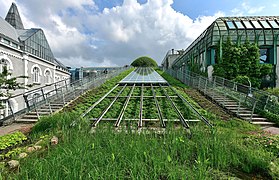




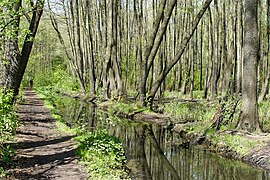
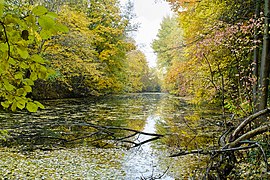


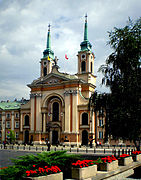


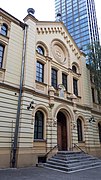



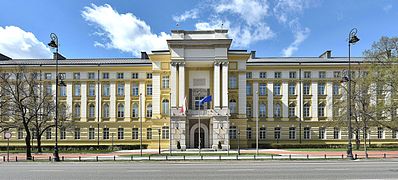

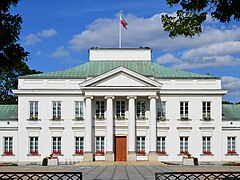






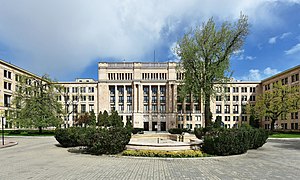

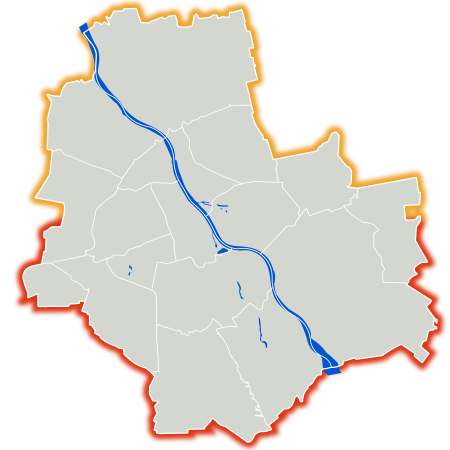

![Wola, once an industrial district, is now becoming the business center of the capital.[163] The photo shows the revitalized Norblin Factory.](http://upload.wikimedia.org/wikipedia/commons/thumb/8/83/Fabryka_Norblina_2022.jpg/300px-Fabryka_Norblina_2022.jpg)
![Praga-Południe, the most densely populated district of Warsaw (8,839 people/km2), is composed mainly of apartment blocks built during the times of the Polish People's Republic.[164]](http://upload.wikimedia.org/wikipedia/commons/thumb/b/b0/Fieldorfa_Street_Wasaw_aerial_2023.jpg/240px-Fieldorfa_Street_Wasaw_aerial_2023.jpg)
![Ochota, a residential district that developed most intensively in the interwar period.[165] The photo shows Narutowicz Square, the central point of the district.](http://upload.wikimedia.org/wikipedia/commons/thumb/4/4d/Plac_Narutowicza_Warsaw_2023_skyline_aerial.jpg/240px-Plac_Narutowicza_Warsaw_2023_skyline_aerial.jpg)
![Wilanów, the district with the highest rate of natural increase (7.2/1000 inhabitants).[164]](http://upload.wikimedia.org/wikipedia/commons/thumb/8/88/Aleja_Rzeczypospolitej_Warsaw_2022_aerial.jpg/240px-Aleja_Rzeczypospolitej_Warsaw_2022_aerial.jpg)



